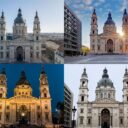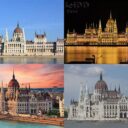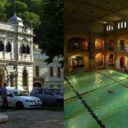Every summer, for ten straight days, three sleepy villages in Hungary—Kapolcs, Taliándörögd, and Vigántpetend—transform into a sprawling playground of concerts, theater, dance, arts, crafts, and more. The Valley of Arts (Művészetek Völgye), now in its 34th edition, is unleashing nearly 3,000 programs between July 18 and 27, 2025. Forget big festival stages; here, streets, historic buildings, and local institutions become pop-up venues filled with exhibitions, shows, and musical happenings from Hungary and beyond.
Whole New Vibes and a Green Revolution
This year brings new venues, the return of audience favorites, and the festival’s most ambitious sustainability plans yet. Expect the usual spectrum of contemporary art galleries, circus acts, dance performances, and hands-on workshops, plus a non-stop playlist of music in every genre imaginable. Bigger names drop in for 2025: Scottish indie legends Franz Ferdinand will take the Panorama Stage with their ‘The Human Fear’ album, featuring cover art inspired by the Hungarian visual artist Dóra Maurer—whose work is also on display in the festival’s permanent exhibition.
But it’s not just about who’s on stage. The entire program kicks off with a uniquely local curtain-raiser: Platon Karataev (Platon Karataev), beloved regulars, join forces with actor-director Miklós Vecsei H., and stars like Kaláka (Kaláka), Henri Gonzo, and László Kollár-Klemencz in a one-off live show, promising countless surprises.
Sustainability remains a core pillar. Expect cup return systems, biodegradable tableware, and a festival-wide push for vegetarian-friendly eating options, all mapped out for hungry attendees in a new gastronomic guide. There’s even a ‘Sportgarden’ (Sportkert): complete exercise sessions, breathing therapy, and yoga for early risers—all with free sports gear for those who put in the effort.
New and Returning Venues
For the first time, the Buda Courtyard (Buda Udvar) brings Budapest’s lively 2nd District (II. kerület) to Kapolcs, with familiar faces from the city’s Jurányi House (Jurányi Ház), Free SZFE (Szabad SZFE), and TÁP Theater (TÁP Színház) setting up new stages. Workshops, talks, and collaborative art sessions spill into the lanes, while the Manyi and Dugattyús venues join the live music circuit.
Vigántpetend welcomes back the ever-funky Cirque du Tókert (Cirque du Tókert) stage, now celebrating the 75th birthday of the Volkswagen Transporter. Festival regular Hobo (Hobo) celebrates his 80th birthday here, joined on stage by Geszti (Péter Geszti), László Dés, Anikó Für, and Pál Mácsai. Budapest Bár (Budapest Bár) and its all-star roster appear, while circus acts from the Rippel Brothers (Rippel fivérek) and iconic dance performances round out the night.
The Sounds of the Valley
Music fans have a dizzying array of choices. Besides Franz Ferdinand, the Panorama Stage features Hungarian stars: Elefánt (Elefánt), Carson Coma (Carson Coma), Beton.Hofi (Beton.Hofi), Bagossy Brothers Company (Bagossy Brothers Company), Quimby (Quimby), Bohemian Betyars (Bohemian Betyars), Margaret Island (Margaret Island), Blahalouisiana (Blahalouisiana), Punnany Massif (Punnany Massif), Belga (Belga), and many more. Big anniversaries are celebrated—15 years of Ivan & The Parazol (Ivan & The Parazol); a quarter-century for 30Y (30Y) and Hiperkarma (Hiperkarma); and 20 years of Irie Maffia (Irie Maffia).
Across the villages, every musical style is represented: world music concerts in partnership with the House of Hungarian Music (Magyar Zene Háza), jazz in the Harcsa Veronika x MOME Courtyard (Harcsa Veronika x MOME Udvar), and late-night DJ sets at Petendi Pajta (Petendi Pajta). Vigántpetend even keeps the party going until sunrise with the ‘Self-Knowledge Disco’ (Önismereti diszkó) and Blue sPot’s (Blue sPot) legendary improv sessions.
Buskers and pop-up gigs abound. The Transport Museum’s (Közlekedési Múzeum) Music Bus is a moving venue with surprise mini-concerts from the likes of Beck Zoli (Zoltán Beck) and Parno Graszt (Parno Graszt)—yes, you can party between stops. There are also international acts from British, Ukrainian, Finnish, Austrian, Slovakian, Czech, Korean, and Indonesian artists, thanks to support from cultural institutes worldwide.
More Than Just Music
If performances aren’t your thing, there’s still plenty to discover. Interactive workshops teach everything from plant care to composting, while art therapy and science sessions keep curious minds busy.
Children and families flock to the new Kaláka Poetry Courtyard (Kaláka Versudvar) for storytelling, digital skills workshops for grandparents, and daily kids’ concerts. The Petőfi Courtyard (Petőfi Udvar) offers literary programming, jam sessions, modern jazz, and a focus on classic and contemporary Hungarian authors. There are fine art exhibits in the MűvészVölgy Mansion (MűvészVölgy Kúria), psychology and wellness talks, film screenings, and—uniquely—an open school-gallery where grownups can relive the joy of doodling on desks and impromptu singing lessons.
And of course, the festival wouldn’t be complete without theater. Over 20 different plays light up two stages, from lighthearted comedies to hard-hitting dramas, with performances by Radnóti Theater (Radnóti Színház), Orlai Productions (Orlai Produkciók), and indie hits starring Hungarian favorites like Andrea Szulák and Armand Kautzky. The ever-popular Momentán improv troupe (Momentán Társulat) delivers laughter in packed shows, turning audience suggestions into unforgettable skits.
Getting There and Getting Around
Getting to and from the Valley is part of the adventure: Csigabusz (Csigabusz) shuttle rides are free with your wristband, and Visa cardholders can hop on the Visa taxi around the festival grounds. Discounted regional bus and rail travel are available, and ample free parking along the village outskirts encourages you to leave your car behind.
Committed to shrinking its footprint, the festival keeps pushing green initiatives—less plastic, more shared rides, and a full embrace of plant-based cuisine. Organizers urge everyone to join the movement—by train, bus, or even just by parking farther out.
Over a thousand events, three villages, and ten days: the Valley of Arts is a full-blown cultural takeover where you’ll need both dancing shoes and walking boots to survive.





